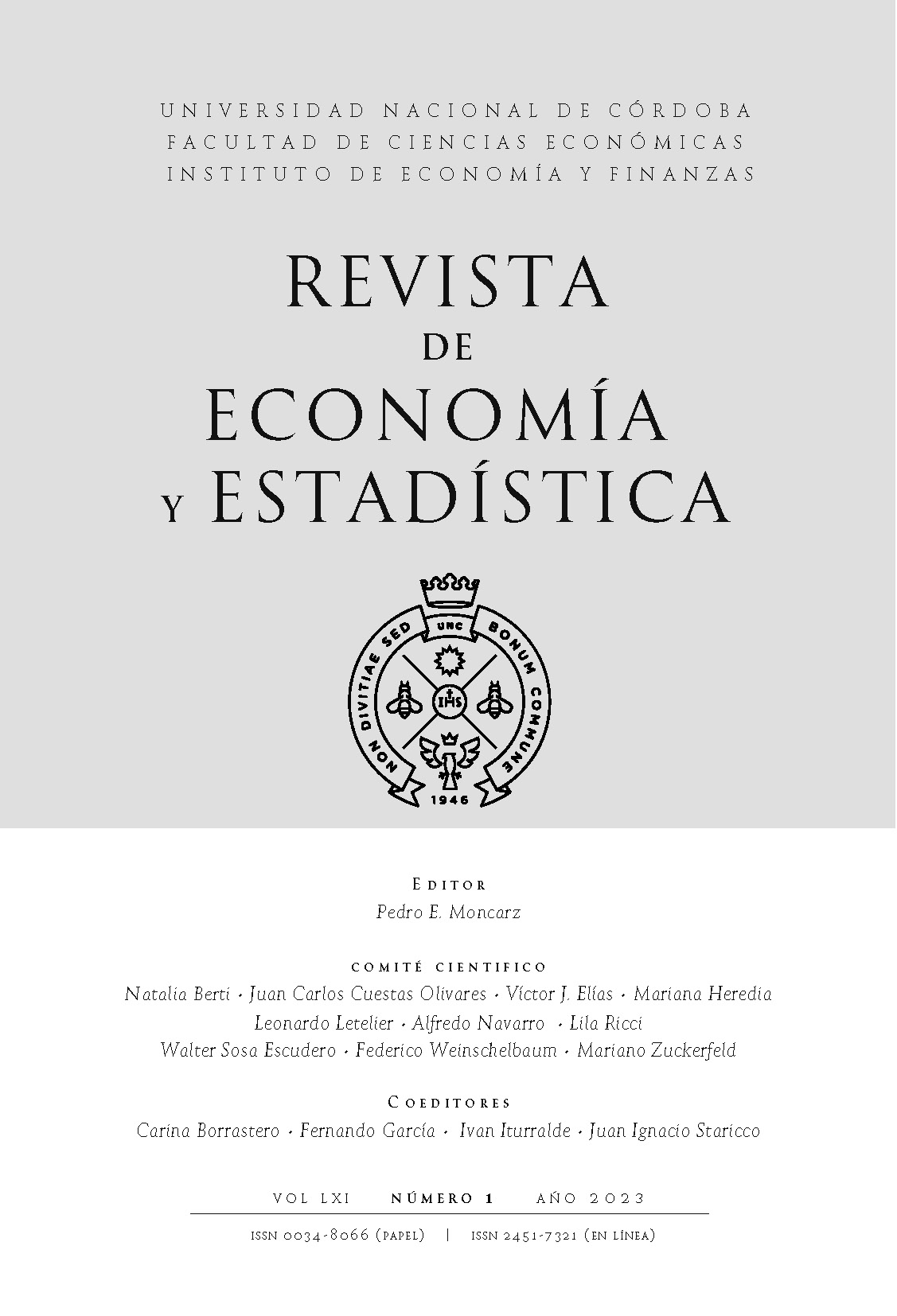Factores del Crecimiento de Largo Plazo y Declinación en Argentina: Un análisis del Siglo XX
DOI:
https://doi.org/10.55444/2451.7321.2023.v61.n1.44195Palabras clave:
Crecimiento de largo plazo, Inestabilidad económica, Siglo XXResumen
Este trabajo explora los determinantes históricos del crecimiento económico de largo plazo en Argentina durante el siglo pasado. La evidencia indica que a principios de siglo la apertura económica jugó un rol clave para explicar el exitoso desempeño alcanzado hasta la gran crisis de 1930. De ahí en más, y hasta mediados de los ´70s, la economía mantuvo un crecimiento similar al del periodo previo, el cual estuvo impulsado por la demanda doméstica vía la inversión. Sin embargo, en el último cuarto del siglo pasado el crecimiento económico se redujo drásticamente, lo cual estuvo principalmente asociado con la inestabilidad económica, aproximada por la inflación y la volatilidad del crecimiento del producto per cápita. La intuición es que una vez que el país perdió mercados para sus exportaciones pudo mantener temporariamente el crecimiento gracias a la demanda interna, pero una vez que esta estrategia se agotó la economía entró en un largo periodo de turbulencia y estancamiento, específicamente desde 1975 en adelante. Por tanto, las recomendaciones de política son desarrollar nuevos sectores productivos orientados a la exportación, de manera de mitigar la restricción externa, así como evitar políticas procíclicas a fin de reducir la inestabilidad económica.
Fecha de recepción: 02/06/2023
Fecha de aceptación: 03/08/2023
Descargas
Referencias
Afonso, A., & Furceri, D. (2010). Government size, composition, volatility and economic growth. European Journal of Political Economy, 26(4), 517-532.
Aisen, A., & Veiga, F. J. (2013). How does political instability affect economic growth? European Journal of Political Economy, 29, 151-167.
Aizenman, J. & Marion, N. (1993). Policy Uncertainty, Persistence and Growth. Review of International Economics, January 1993, 1 (2), pp. 145-63.
Alesina, A., Özler, S., Roubini, N., & Swagel, P. (1996). Political instability and economic growth. Journal of Economic Growth, 1(2), 189-211.
Alagidede, P., & Ibrahim, M. (2017). On the causes and effects of exchange rate volatility on economic growth: Evidence from Ghana. Journal of African Business, 18(2), 169-193.
Astorga, P. (2010). A century of economic growth in Latin America. Journal of Development Economics, 92(2), 232-243.
Awokuse, T. O. (2008). Trade openness and economic growth: is growth export-led or import-led? Applied economics, 40(2), 161-173.
Baglan, D., & Yoldas, E. (2014). Non-linearity in the inflation–growth relationship in developing economies: Evidence from a semiparametric panel model. Economics Letters, 125(1), 93-96.
Bakari, S., & Krit, M. (2017). The nexus between exports, imports and economic growth: Evidence from Mauritania. International Journal of Economics and Empirical Research, 5(1), 10-17.
Balcilar, M., Gupta, R., & Jooste, C. (2014). The Growth-Inflation Nexus for the US over 1801-2013: A Semiparametric Approach. Journal of Applied Economics (No. 15-17).
Bermúdez, C., Dabús, C. , & González, G. (2015). Reexamining the link between instability and growth in Latin America: a dynamic panel data estimation using K-Median clusters. Latin american journal of economics, 52(1), 1-23.
Bittencourt, M. (2012). Inflation and economic growth in Latin America: Some panel time-series evidence. Economic Modelling, 29(2), 333-340.
Bittencourt, M., Van Eyden, R., & Seleteng, M. (2015). Inflation and Economic Growth: Evidence from the Southern African Development Community. South African Journal of Economics, 83(3), 411-424.
Breusch, T. S., & Pagan, A. R. (1979). A simple test for heteroscedasticity and random coefficient variation. Econometrica, 1287-1294.
Bruno, M., & Easterly, W. (1998). Inflation crises and long-run growth. Journal of Monetary economics, 41(1), 3-26.
Buera, F., Navarro, G., & Nicolini, J. P. (2011). The Argentine economy after two centuries. Latin American Journal of Economics, 48(2), 133-156.
Dabús, C. (2000). Inflationary Regimes and Relative Price Variability. Journal of Development Economics, 62 (2), 535-547.
Dabús, C.& Viego, V. (2003). Inflación, Precios Relativos y Crecimiento: Evidencia de América Latina. Estudios de Economía Aplicada, 21 (1), 91-107.
Dabús, C., González, G. & Cecilia Bermúdez (2012): Inestabilidad y Crecimiento Económico en América Latina, in Saúl Keifman, ed., Progresos en Crecimiento Económico, Buenos Aires: Edicon, 117–65.
Dabús, C., Delbianco, F., & Fioriti, A. (2016). High inflation, price stability and hysteresis effect: evidence from Argentina. Revista de Análisis Económico–Economic Analysis Review, 31(1), 59-74.
Dabús, C., & Delbianco, F. (2019). Exports, terms of trade and economic growth: evidence from countries with different level of openness. Journal of Reviews on Global Economics, 8, 327-336.
Davidson, R., & J. G. MacKinnon. (1993). Estimation and Inference in Econometrics. NewYork: Oxford University Press.
De Gregorio, J. (1992). Economic Growth in Latin America, Journal of Development Economics, 39 (1), 59-84.
Dao, A. (2014). Trade openness and economic growth, Illinois Wesleyan University Economics Department Working Papers.
Dickey, D. A., & Fuller, W. A. 1979. Distribution of the estimators for autoregressive time series with a unit root. Journal of the American Statistical Association 74: 427–431.
Fatás, A. & Mihov, I. (2013). Policy Volatility, Institutions, and Economic Growth, The Review of Economics and Statistics, 95 (2), 362-376.
Ferrer, A. (2004). La economía argentina: desde sus orígenes hasta principios del siglo XXI. Buenos Aires: Fondo de Cultura económica.
Ferreres, O. J. (2005). Dos siglos de economía argentina, 1810-2004: historia argentina en cifras. Editorial El Ateneo.
Gerchunoff, P. & Rapetti, M. (2016). La Economía Argentina y su Conflicto Distributivo Estructural (1930-2015), El Trimestre Económico, Vol. LXXXIII (2), 225-272.
Gries, T. & Redlin, M. (2012). Trade Openness and Economic Growth: A Panel Causality Analysis, University of Paderborn working paper.
Gylfason, T. & Herbertsson, T. (2001). Does inflation matter for growth? Japan and the World Economy, 13 (4) (2001), pp. 405–428.
Idris, J., Zulkornain Y. & Muzafar, S. (2016). Trade openness and economic growth: A causality test in panel perspective, International Journal of Business and Society, 17 (2), 281-290.
Hye, Q., Adnan, M. & Wee-Yeap, L. (2015). Trade openness and economic growth: empirical evidence from India, Journal of Business Economics and Management, 16 (1), 188-205.
Hnatkovska, V. & Loayza, N. (2005). Volatility and Growth, in Joshua Aizenman and Brian Pinto, eds., Managing Volatility and Crises: A Practitioner’s Guide, Cambridge: Cambridge University Press.
Hussain, I., Khan, Z. and Rafiq, M. (2017). Compositional Changes in Public Expenditure and Economic Growth: Time Series Evidence from Pakistan, Business and Economic Review, 9 (1), 1-20.
Idris, J., Zulkornain, Y. & Muzafar, S. (2016). Trade openness and economic growth: A causality test in panel perspective, International Journal of Business and Society, 17 (2), 281-290.
Kalyuzhnova, Y. & Patterson, K. (2016). Kazakhstan: long-term economic growth and the role of the oil sector. Comparative Economic Studies 58.1 (2016): 93-118.
Kharusi, S. A., & Ada, M. S. (2018). External debt and economic growth: The case of emerging economy. Journal of Economic Integration, 33(1), 1141-1157.
Khan, M. S., & Ssnhadji, A. S. (2001). Threshold effects in the relationship between inflation and growth. IMF Staff papers, 48(1), 1-21.
Kose, M. A., Prasad, E. S., & Terrones, M. E. (2006). How do trade and financial integration affect the relationship between growth and volatility? Journal of international Economics, 69(1), 176-202.
Kremer, S., Bick, A., & Nautz, D. (2013). Inflation and growth: new evidence from a dynamic panel threshold analysis. Empirical Economics, 44(2), 861-878.
Mbulawa, S. (2017). The impact of economic infrastructure on long term economic growth in Botswana. Journal of Smart Economic Growth, 2(1), 15-33.
Menyah, K., Nazlioglu, S., & Wolde-Rufael, Y. (2014). Financial development, trade openness and economic growth in African countries: New insights from a panel causality approach. Economic Modelling, 37, 386-394.
Minoiu, C., & Reddy, S. G. (2010). Development aid and economic growth: A positive long-run relation. The Quarterly Review of Economics and Finance, 50(1), 27-39.
Musa, A, & Al-Jaberi, Q. (2016): The Relationship between Economic Development and Political Stability: Iraq as a Case Study for the Period 1970-2014, University of Mustansiriya Working Paper.
Pradhan, R. P., Arvin, M. B., Hall, J. H., & Nair, M. (2016). Innovation, financial development and economic growth in Eurozone countries. Applied Economics Letters, 23(16), 1141-1144.
Ojo, O., & Oshikoya, T. (1995). Determinants of long-term growth: Some African results. Journal of African economies, 4(2), 163-191.
Bahmani-Oskooee, M., & Niroomand, F. (1999). Openness and economic growth: an empirical investigation. Applied Economics Letters, 6(9), 557-561.
Otani, I. & Villanueva, D. (1990). Long-Term Growth in Developing Countries and its Determinants: An Empirical Analysis, World Development, 18 (6), 769-783.
Pindyck, R. (1991). Irreversibility, Uncertainty, and Investment. Journal of Economic Literature, September 1991, 29(3), pp. 1110-48.
Ramey, G. & Ramey, V. (1995). Cross-Country Evidence on the Link between Volatility and Growth, American Economic Review 85(5), 1138-51.
Rapoport, M. (2007). Mitos, etapas y crisis en la economía argentina. Nación-Región-Provincia en Argentina, Pensamiento político, económico y social, 9-28.
Sakyi, D., Villaverde, J. & Maza, A. (2015). Trade openness, income levels, and economic growth: The case of developing countries, 1970–2009, The Journal of International Trade and Economic Development, 24 (6), 860-882.
Sala-i-Martin, X., Doppelhofer, G. & Miller, R. (2004). Determinants of Long-Term Growth: A Bayesian Averaging of Classical Estimates (BACE) Approach, The American Economic Review, 94 (4), 813-835.
Simionescu, M., Lazányi, K., Sopková, G., Dobeš, K., & Balcerzak, A. P. (2017). Determinants of economic growth in V4 countries and Romania. Journal of Competitiveness.
Solimano, A. & Soto, R. (2003). Latin American Economic Growth in the late 20th Century: Evidence and Interpretation, Serie Macroeconomía del Desarrollo No. 33, CEPAL.
Soto, R. & Zurita, F. (2011). Two Centuries of Economic Growth in Latin America at its Bicentennial Celebration, Latin America Journal of Economics, 48 (2), 113-132.
Tahir, M. & Azid, T. (2015). The relationship between international trade openness and economic growth in the developing economies: Some new dimensions, Journal of Chinese Economic and Foreign Trade Studies, 8 (2), 123-139.
Tamura, R., Dwyer, J., Devereux, J., & Baier, S. (2019). Economic growth in the long run. Journal of Development Economics, 137, 1-35.
Taylor, A. (1998). On the Costs of Inward-Looking Development: Price Distortions, Growth, and Divergence in Latin America, The Journal of Economic History, 58 (1), 1-28.
Tochkov, K. & Tochkov, K. (2009) .Is Higher Volatility Associated with Lower Growth? Intranational evidence from South Korea, Empirical Economics Letters 8(7): 625-9.
Ulaşan, B. (2015). Trade openness and economic growth: panel evidence, Applied Economic Letters, 22 (2), 163-167.
Vaona, A. & Schiavo, S. (2007). Nonparametric and semiparametric evidence on the long-run effects of inflation on growth, Economic Letters, 94 (3), 452-458.
Vedia-Jerez, D. H., & Chasco, C. (2016). Long-run determinants of economic growth in South America. Journal of Applied Economics, 19(1), 169-192.
Vogiatzoglou, K. & Nguyen, P. (2016). Economic Openness and Economic Growth: a Co-integration Analysis for Asean-5 Countries, The European Journal of Applied Economics, 13 (2), 10-20.
Zeren, F., & Ari, A. (2013). Trade openness and economic growth: A panel causality test. International Journal of Business and Social Science, 4(9).
Descargas
Publicado
Número
Sección
Licencia
Derechos de autor 2023 Carlos Dabús, Fernando Delbianco

Esta obra está bajo una licencia internacional Creative Commons Atribución-NoComercial-SinDerivadas 4.0.
Aquellos autores/as que tengan publicaciones con esta revista, aceptan los términos siguientes:
Los autores/as conservarán sus derechos de autor y garantizarán a la revista el derecho de primera publicación de su obra, el cuál estará simultáneamente sujeto a la Licencia Creative Commons Atribución-NoComercial-SinDerivar 4.0 Internacional que permite a terceros compartir la obra siempre que se indique su autor y su primera publicación esta revista.
Los autores/as podrán adoptar otros acuerdos de licencia no exclusiva de distribución de la versión de la obra publicada (p. ej.: depositarla en un archivo telemático institucional o publicarla en un volumen monográfico) siempre que se indique la publicación inicial en esta revista.
Se permite y recomienda a los autores/as difundir su obra a través de Internet (p. ej.: en archivos telemáticos institucionales o en su página web) antes y durante el proceso de envío, lo cual puede producir intercambios interesantes y aumentar las citas de la obra publicada. (Véase El efecto del acceso abierto)














